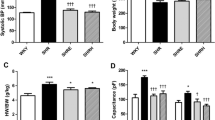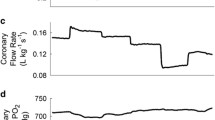Summary
In order to test the effect of arterial hypertension on cardiac electrical activity, isolated Langendorff perfused hearts from spontaneously hypertensive (SHR) and normotensive (WKY) rats were studied. The incidence of spontaneous ventricular arrhythmias occurring during the control perfusion was 0% (n=28) in WKY, 31% in SHR (n=29, p<0.01), 7% (n=14) in 3-month-old SHR, and 53% in 14-month-old SHR (n=15, p<0.05). The incidence of venticular arrhythmias induced by programmed electrical stimulation (PES=stimulus train+two extrastimuli) was 18% in WKY (n=28), 48% in SHR (n=27, p<0.05), 29% (n=14) in 3-month-old SHR, and 69% (n=13) in 14-month-old SHR (p<0.05). The incidence of PES-induced irreversible ventricular fibrillation was 0% in WKY and in 3-month-old SHR (n=42), whereas it was 38% (n=13) in 14-month-old SHR (p<0.001). Myocardial norepinephrine was significantly reduced in SHR with respect to WKY, but no significant difference was observed between 3-month-old SHR and 14-month-old SHR. Thus, no correlation between myocardial norepinephrine and ventricular arrhythmias could be found. It was concluded that the duration of hypertension was the most important factor in the development of severe ventricular arrhythmias.
Similar content being viewed by others
References
Messerli FH, Ventura HO, Elizardi DJ, et al. Hypertension and sudden death: Increased ventricular ectopic activity in left ventricular hypertrophy.Am J Med 1984; 77:18–22.
MC Lenachan JM, Henderson E, Morris K, et al. Ventricular arrhythmias in patients with hypertensive left ventricular hypertrophy.N Engl J Med 1987; 317:787–792.
Kannel WB, Gordon T, Offutt D Left ventricular hypertrophy by electrocardiogram. Prevalence, indicence and mortality in the Framingham Study.Ann Int Med 1969; 71:89–105.
Kannel WB, Sorlie P. Left ventricular hypertrophy in hypertension: Prognostic and pathogenetic implications (the Framingham study). In: Straner BE (ed.)The Heart in Hypertension. Berlin: Springer-Verlag, 1981:223–242.
Yamori Y. Development of the spontaneously hypertensive rat (SHR) and of various spontaneous rat models, and their implications. In: de Jong W (ed.)Handbook of Hypertension. Vol. 4. Experimental and Genetic Models of Hypertension. London: Elsevier, 1984:224–239.
Tisne Versailles J, Verscheure Y, Le Kim A, et al. Comparison between the ventricular fibrillation thresholds of spontaneously hypertensive and normotensive rats—investigation of antidysrhythmic drugs.J Cardiovasc Pharmacol 1982; 4:430–435.
Carbonin PU, Di Gennaro M, Valle R, et al. Inhibitory effect of anoxia on reperfusion- and digitalis-induced ventricular tachyarrhythmias.Am J Physiol 1981; 240:H730–737.
Pahor M, Di Gennaro M, Cocchi A, et al. Age-related incidence of reperfusion- and reoxygenation-induced ventricular tachyarrhythmias in the isolated rat heart.Gerontology 1985; 31:15–26.
Scheuer J, Stezoski SW. The effects of high energy phosphates depletion and replication on the dynamics and electrocardiogram of the isolated rat heart.Circ Res 1968; 23:519–530.
Wagner J, Palfreyman M, Zraika M. Determination of dopa, dopamine, dopac, epinephrine, norepinephrine, alphamonofluoro, alpha-methyldopa and alpha-difluoromethyldopa in various tissues of mice and rats using reverse-phase ionpair chromatography with electrochemical detection.J Chrom 1979; 164:41–54.
Lowry OH, Rosenrough NJ, Lewis Farr A, et al. Protein measurement with the Folin phenol reagent.J Biol Chem 1951; 193:266–270.
Wallenstein S, Zucker CL, Fleiss JL. Some statistical methods in circulation research.Circ Res 1980; 47:1–9.
Lown B, Verrier RL, Rabinowitz SH. Neural psychologic mechanisms and the problem of sudden cardiac death.Am J Cardiol 1977; 39:890–902.
Ueba Y, Mori K, Tomamatsu T. Modification of catecholamine metabolism in spontaneously hypertensive rats. In: Okamoto K (ed.)Spontaneous Hypertension. Berlin: Springer-Verlag, 1972:64–66.
Howe PRC, Provis JC, West MJ, et al. Changes in cardiac norepinephrine in spontaneously hypertensive and strokeprone rats.J Cardiovasc Pharmacol 1979; 1:115–122.
Curtis MJ, Macleod BA, Walker MJA. The effects of ablations in the central nervous system on the arrhythmias induced by coronary occlusion of the heart.Br J Pharmacol 1985; 86:663–670.
Botting JH, Johnston KM, Macleod BA, et al. The effect of modification of sympathetic activity on responses to ligation of the coronary artery in the conscious rat.Br J Pharmacol 1983; 79:265–271.
Daugherty A, Frayn KN, Redfern WS, et al. The role of catecholamines in the production of ischaemia-induced ventricular arrhythmias in the rat in vivo and in vitro.Br J Pharmacol 1986; 87:265–277.
Rosen MP. Is the response to programmed electrical stimulation diagnostic of mechanisms for arrhythmias?Circulation 1986; 73 (Suppl II):18–27.
Janse MJ, Kleber AG. Electrophysiological changes and ventricular arrhythmias in the early phase of regional myocardial ischemia.Circ Res 1981; 49:1069–1081.
Gardner P, Ursell PC, Fenoglio JJ, et al. Electrophysiologic and anatomic basis for fractionated electrograms recorded from healed myocardial infarcts.Circulation 1985; 72:596–611.
Pfeffer JM, Pfeffer MA, Fishbein MC, et al. Cardiac function and morphology with aging in the spontaneously hypertensive rat.Am J Physiol 1979; 237:H461–H468.
Aronson RS. Afterpotentials and triggered activity in hypertrophied myocardium from rats with renal hypertension.Circ Res 1981; 48:720–727.
Bernabei R, Pahor M, Di Gennaro M, et al. Age-related incidence of different types of arrhythmias in the isolated rat heart (abstract).J Mol Cell Cardiol 1986; 18(Suppl I):270.
Author information
Authors and Affiliations
Rights and permissions
About this article
Cite this article
Pahor, M., Giudice, P.L., Bernabei, R. et al. Age-related increase in the incidence of ventricular arrhythmias in isolated hearts from spontaneously hypertensive rats. Cardiovasc Drug Ther 3, 163–169 (1989). https://doi.org/10.1007/BF01883860
Issue Date:
DOI: https://doi.org/10.1007/BF01883860




